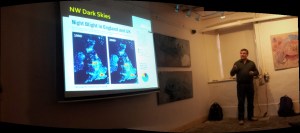Late last night, after quite a few cloudy nights in a row, I managed to grab some photos. Stella and I headed up to Shap just after 10, and were later joined by Carol, and before a huge bank of filthy black cloud barrelled in, bringing with it rain and a chill wind, I managed to get some pretty nice pictures with my iOptron star tracker.
As you probably know, I’ve been following Comet Lovejoy since last Christmas (my first sighting of it was actually on Boxing Day evening, from Kendal Castle). For a while it was visible to the naked eye, and was a very pretty comet, but it has faded a lot now, and is now only visible to small telescopes and binoculars. It is now just beneath the Pole Star, Polaris, and over the next week and a half will slowly drift up towards and then pass that famous star…

Last night I managed to take a few more pictures, ad here’s the result after stacking and processing them…

I also managed to take some pictures of the famous “North American Nebula”, near Deneb, one of my favourite photographic objects…

Really pleased with that! 🙂
But what I really was hoping to photograph was the Milky Way, now coming back into view after languishing beneath the horizon since late autumn. I was very interested to see what the iOptron tracker would do when used on the star-clouds and dust lanes of the Milky Way – and I wasn’t disappointed…

Can’t wait to get to the Dalby star party in August and let the tracker loose on the summer Milky Way as it cuts the sky in half…!














